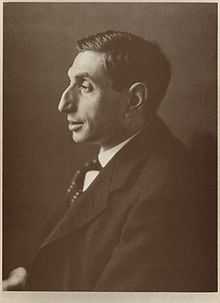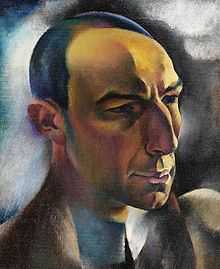Alfred Flechtheim
| Alfred Flechtheim | |
|---|---|
 Alfred Flechtheim, 1910 | |
| Born |
April 1, 1878 Münster, Westphalia, German Empire |
| Died |
March 9, 1937 (aged 58) London, England |
| Nationality | Germany |
| Occupation | Art dealer |
| Spouse(s) | Betty Goldschmidt (m. 1910) |
Alfred Flechtheim (April 1, 1878 – March 9, 1937) was a German art dealer, art collector, journalist and publisher.
Early Years
Flechtheim was born into a Jewish merchant family; his father, Emil Flechtheim, was a grain dealer. Alfred became a partner in his father's company after business internships in London and Paris.[1]
Art Dealer
Flechtheim appeared in the art world shortly after 1900, with a collection of paintings by Vincent van Gogh und Paul Cézanne; French Avant garde early works of Pablo Picasso, Georges Braque and André Derain; paintings of Wassily Kandinsky, Maurice de Vlaminck, Alexej von Jawlensky, Gabriele Münter, and the Rhein Expressionists Heinrich Campendonk, August Macke, Heinrich Nauen , and Paul Adolf Seehaus . Flechtheim opened his first gallery in Düsseldorf in 1913, followed by galleries in Berlin, Frankfurt, Cologne, and Vienna.[2]
Later career
Flechtheim served in the German Army during World War I, but not at the front. His art business collapsed during the war but he re-opened in Düsseldorf in 1919.[3] In 1921 he founded Der Querschnitt (the Cross Section), a cultural magazine. Legendary, glamorous parties in Flechtheim's gallery overflowed with the glitterati of the new Berlin: movie stars, titans of finance, prizefighters and artists of every stripe.[4]
Flechtheim and the Nazis
As Hitler rose to power in the late 1920s and early 1930s, Flechtheim became a bête noire because of the art he espoused and championed. In 1933, Sturmabteilung men broke up an auction of Flechtheim's paintings. The Nazis aryanized Flechtheim's gallery, as they would many other Jewish businesses,[5] and turned it over to Flechtheim's business manager, Alex Vömel. After the war, former party member Vömel said he didn't even remember who Flechtheim was. The Nazis seized and sold off Flechtheim's private collection, as well as the contents of his gallery.
Emigration and Death
Six months after the Nazis came to power in 1933, Flechtheim, penniless, fled to Paris, and tried to find work with his former business partner, Daniel-Henry Kahnweiler. Flechtheim subsequently organized exhibits in London of the paintings of exiled German artists. In London, Flechtheim slipped on a patch of ice, was taken to a hospital, punctured his leg on a rusty nail in his hospital bed, developed septicemia leading to amputation of his leg, and died.
Personal life
Flechtheim married Betty Goldschmidt, a wealthy Dortmund merchant's daughter. On a honeymoon trip to Paris, Flechtheim invested Betty's dowry in cubist art, to the horror of his inlaws. The marriage was childless. Betty Flechtheim was with her husband in London during his final days. Then she returned to Berlin. In 1941, when she was ordered to report for deportation to Minsk, she ingested a lethal dose of Veronal. The Gestapo seized her art collection.[6]
Recovery of artworks
Flechtheim's heirs are attempting to recover artworks stolen from Flechtheim. These works reside in German museums and the Museum of Modern Art.[7]
Gallery
-

Portrait of Alfred Flechtheim by Hanns Bolz (1885-1918)
-
_Alfred_Flechtheim.jpg)
Memorial plaque, Berlin
-

Alfred Flechtheim dressed as a toreador by Jules Pascin, 1927
-
_Bertha_Betty_Flechtheim.jpg)
Memorial paving stone for Betty Flechtheim, wife of Alfred Flechtheim, Berlin
References
- ↑ Gee, Malcolm (1981). Dealers, Critics, and Collectors of Modern Painting: Aspects of the Parisian Art Market between 1910 and 1930. London: Garland. ISBN 0-8240-3931-9.
- ↑ Sontheimer, Michael (25 June 2012). "Stärker als Spiel, Alkohol und Weiber". Der Spiegel (in German) (26/2012).
- ↑ Malcolm Gee, ‘The Berlin Art World, 1918-1933’ in: Malcolm Gee, Tim Kirk and Jill Steward (eds), The City in central Europe : culture and society from 1800 to the present, Ashgate, 1999.
- ↑ Dascher, Ottfried (2011). "Es ist was Wahnsinniges mit der Kunst": Alfred Flechtheim. Sammler, Kunsthändler und Verleger (in German). Wädenswil: Nimbus. ISBN 978-3-907142-62-2.
- ↑ Lehrer, Steven (2000). Wannsee House and the Holocaust. Jefferson, NC: McFarland. pp. 36–47. ISBN 0-7864-4092-9.
- ↑ Koldehoff, Stefan (30 June 2010). "Mit deutschen Grüßen". Die Welt (in German).
- ↑ Burleigh, Nina. "Haunting MoMA: The Forgotten Story of ‘Degenerate’ Dealer Alfred Flechtheim". Gallerist New York.
|